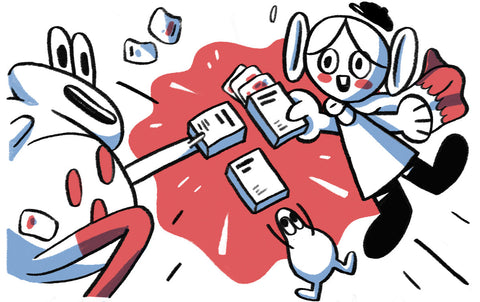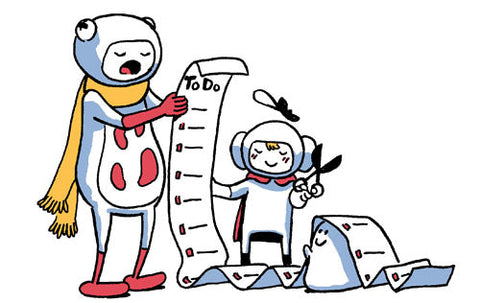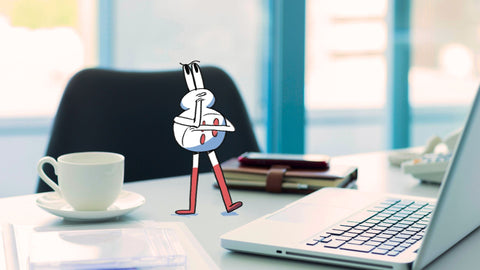Wake up.
Do stuff.
Smash goals.
Sleep.
Repeat.
Die.
…Life moves pretty fast.
We all have a fixed amount of time. That might sound morbid, but it’s true. How best to spend it is a personal question – I can’t tell you what to value, or where to find meaning. But there are tools that help you weigh up what matters and get stuff done, and I can tell you plenty about those.
To accomplish more at work and in life, you must use your time wisely. That means ignoring some things so you can focus on others – so how do you decide what to dismiss, and what to pursue? How do you break your most high-impact tasks into manageable steps?
There are some simple task management techniques and templates that will help you – we’ll get to those. But your mindset matters too; mindfully prioritising means letting go of the illusion that you can do everything, and having a clear sense of the outcomes you want.
Ever thought about the etymology of the word "to decide"? It stems from the Latin words "de" (off) and "caedere" (to cut). So, deciding something means to determine what to keep and what to cut away - and actually cutting it. It's a deliberate action with a consequence.
— Oliver Finker (@ofinker) February 28, 2019
The best way to approach tasks and to-do lists is in the spirit of essentialism – the disciplined pursuit of less.
Everyone’s different, but for me anything more than three things on a daily to-do list is too much. The ideal is usually one. The most high-value tasks deserve full focus, and that’s hard when there’s lots more stuff waiting to be ticked off. Limiting your work-in-progress also forces you to break things down into workable chunks (“because if 'write book' or 'get new job' is one of your tasks, it’ll jam things up for months”).
If you’ve been wondering how to get more done, that’s probably the wrong question. Getting the right stuff done, and doing work you feel proud of, is what matters.
OK – let’s start getting practical.
Task prioritisation methods
To prioritise effectively, you need to know what outcome you’re hoping for. If you’re not clear on that, spend time articulating your vision and setting goals first. Tools like meditation and therapy may well be helpful here too, especially if you’re fuzzy about your personal values and ambitions.
At any moment, there are a bunch of things you could decide to work on – maybe you have a list of potentially promising ideas from a workshop, or you have a few new opportunities you need to choose from. You can begin by ranking your ideas/opportunities using a simple technique like blind voting (this is a group activity) or $100 (you can do this in a group or on your own). Once you’ve ranked them, you can add the most valuable tasks to a plan (a fancy word for a to-do list).
For a more nuanced view, you can use a priority map (alone or with others) – this lets you plot tasks on two axes, such as impact vs effort, so you can find tasks that are both doable and worthwhile. Just don’t always expect too much gold in the low-effort/high-impact corner – if the tasks with the biggest rewards were easy, everyone would be doing them.
But great careers aren’t built on doing the same things as everyone else; neither are great products. If there’s a task on your radar that feels a bit too weird or uncertain to prioritise, ask yourself what you might be risking by “playing it safe”.
The best to-do list tools and templates
Nothing beats some wall space or a whiteboard where you can scribble ideas down and capture tasks on sticky notes. But digital tools can be super helpful too.
If you’re truly living the essentialist life, you might not need anything more advanced than Apple Notes or Google Keep on your phone. Perhaps just a pen and paper, in fact.
For simple reminders, I’m a big fan of using Slackbot (just go to Slackbot in Slack and type “Remind me [thing] at [time] [date]”).
For more complex to-do lists, I find Trello the most intuitive, versatile tool for capturing, visualising and tracking tasks, usually using something resembling Kanban.
You might prefer something like Notion or Sunsama, which was recommended by Pip community member Rachel Davis – “it has really helped me organise multiple to dos across clients and personal” and “it warns you if you go over whatever amount of hours you set you want to work and helps you keep your sanity”.
Always choose the tool that helps you keep your sanity! After trying four popular to-do list methods, one HBR editor concluded:
“No one method is really better than the other — what works for you will depend on your own quirks, habits, and what you’re trying to accomplish. So experiment! And make sure to leave some blank space on your calendar to relax."
If you like templates, though, here are 22 free ones in Word, Google Docs, Excel and PDF format.
What about my constant procrastination?
Doing the washing up is never more appealing than when you’ve got a really important task you need to complete, right? Distracting ourselves has never been easier – you could reorganise your cutlery drawer, you could actually go on that jog, or you could just disappear into the social media vortex for a while. So many options!
If you find yourself procrastinating a lot, it might be because you’re a perfectionist, and delaying a task feels less painful in the moment than confronting your own flawed humanity. People say “done is better than perfect”, but that misses the point – perfection doesn’t exist. Getting the thing done is all there is – sure, use your skills to the full, but remember that every task is practice. Every task is a chance to learn, to play, and to get a tiny bit better at the thing.
If you find you’re often putting tasks or decisions off because you don’t quite have enough information to get started, the 70% rule might help – inspired by Jeff Bezos, this is the simple maxim that when you feel about 70% sure about something, that’s the best time to act.
When you’re prioritising tasks, reflecting on goals can be useful, but when you’re in doing mode, a focus on outcomes is often unhelpful. Instead, focus on having fun in the process – the outcomes will probably be better as a result.
Personally, I find some of my best insights and most creative ideas emerge when I’m actively avoiding something on my list or inventing new tasks for myself – this makes it hard to see procrastination as an absolute evil. 'Structured procrastination' is a fascinating reframe:
“Structured procrastination means shaping the structure of the tasks one has to do in a way that exploits this fact. The list of tasks one has in mind will be ordered by importance. Tasks that seem most urgent and important are on top. But there are also worthwhile tasks to perform lower down on the list. Doing these tasks becomes a way of not doing the things higher up on the list.”
If you still need a little extra help getting going, Nick Parker’s Get the f*ck on with it cards are a pretty compelling solution.
Never mindlessly stick to a plan
To-do lists are great, but don’t follow them blindly.
Be open to prioritising new ideas or opportunities if they’re more promising than what’s already on your list. Update your plans as you learn.
Approach execution with mindful awareness – how does doing this task make you feel? Is it making the world better in some small way? Is it providing some satisfaction, perhaps even some joy? If not, it might be a worthless task you can cut out, or could be a recurring task that’s become boringly routine. When you notice you’re drifting through a task on autopilot, step away, reset, and ask yourself “how can I make this more fun?”
We’ll end with some words from my favourite writer on productivity – Oliver Burkeman:
“What if there's nothing you ever have to do to earn your spot on the planet? What if everything you actually get around to doing, on any given day, is in some important sense surplus to minimum requirements?”
Remember friends: you are enough.









